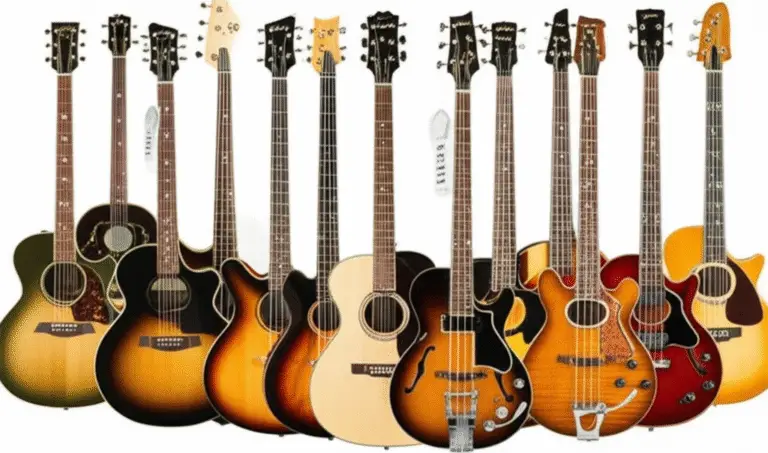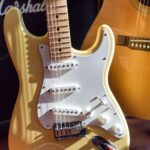Support our educational content for free when you purchase through links on our site. Learn more
What Brand of Guitar Is This? 🎸 Ultimate Guide to ID Your Axe (2025)
Ever picked up a guitar and wondered, “What brand of guitar is this?” You’re not alone. Whether it’s a dusty attic find, a pawn shop surprise, or a gift from a mysterious relative, identifying your guitar’s brand can feel like cracking a secret code. But fret not! We’re here to turn you into a guitar detective with insider tips, historical clues, and expert tricks that will have you naming brands like a pro in no time.
Did you know that the shape of a headstock or the tiniest logo detail can reveal a guitar’s origin and even its age? Later in this guide, we’ll show you how to decode serial numbers, spot authentic logos, and even use blacklight tests to uncover hidden truths about your instrument. Plus, we’ll reveal the top 10 most recognizable guitar brands and how to tell them apart at a glance. Ready to solve the mystery behind your six-string? Let’s dive in!
Key Takeaways
- Headstock logos and shapes are your first clues to identifying guitar brands.
- Serial numbers unlock manufacturing dates and authenticity when cross-referenced with official brand databases.
- Hardware, inlays, and finish details provide vital hints about a guitar’s origin and era.
- Online tools, apps, and communities can fast-track your identification journey.
- Understanding brand history helps spot fakes and appreciate your guitar’s story.
With these insights, you’ll confidently answer the question: “What brand of guitar is this?” and maybe even discover a hidden gem!
Table of Contents
- ⚡️ Quick Tips and Facts About Identifying Guitar Brands
- 🎸 Guitar Brand History and How to Spot Authenticity
- 🔍 What Kind of Guitar Is This? A Step-by-Step Identification Guide
- 🕰️ How Old Is This Guitar? Dating Your Instrument Like a Pro
- 💰 What’s It Worth? Understanding Guitar Value and Market Trends
- 🎯 The Top 10 Most Recognizable Guitar Brands and Their Signature Features
- 🛠️ Common Guitar Brand Markings, Logos, and Serial Numbers Explained
- 📱 Best Apps and Online Tools to Identify Your Guitar Brand Instantly
- 🎥 Video Tutorials and Expert Reviews on Guitar Brand Identification
- 🤔 What Is This Stupid Thing? Decoding Weird Guitar Parts and Accessories
- ⭐️ Most Popular Vintage and Modern Guitar Brands Among Collectors
- 🔥 Don’t Miss Out: Insider Tips from Luthiers and Guitar Experts
- 📚 Conclusion: Mastering the Art of Guitar Brand Identification
- 🔗 Recommended Links for Guitar Brand Research and Community
- ❓ FAQ: Your Burning Questions About Guitar Brands Answered
- 📖 Reference Links and Resources for Further Exploration
Here is the main body of the article, written as requested.
⚡️ Quick Tips and Facts About Identifying Guitar Brands
Hey there, fellow tone chasers! Welcome to the Guitar Brands™ workshop. So, you’ve got a mystery guitar on your hands? An attic find, a pawn shop prize, or maybe just a hand-me-down with a story to tell. You’re asking, “What brand of guitar is this?” and boy, do we have answers for you. Before we dive deep, here are some lightning-round tips to get you started:
- The Headstock is Your ID Card: 90% of the time, the brand name is right on the headstock. Look for a logo or a specific shape. A Fender’s graceful curve is worlds away from a pointy Jackson headstock!
- Look Inside: For acoustic guitars, the answer is often just a peek away. Look through the soundhole for a paper label. This usually has the brand, model, and sometimes even the serial number.
- Serial Numbers Are Your Friend: Most guitars have a serial number, typically on the back of the headstock or on the neck plate (where the neck bolts to the body). This is your key to unlocking the manufacturing date and origin.
- Hardware Tells a Story: The style of the tuning pegs, the bridge, and the pickups can be big clues. Brands often use specific hardware suppliers like Grover, Schaller, or Floyd Rose.
- Don’t Forget the Case: Sometimes, the original case has a brand logo on it, even if the guitar’s logo has worn away. The case candy (manuals, tags) is a goldmine of information!
- When in Doubt, Ask the Hive Mind: Online forums like The Gear Page or Reddit’s r/guitars are full of eagle-eyed experts who love a good guitar mystery.
Did you know that some of the most iconic sounds in music came from now-forgotten brands? Check out our deep dive into 8 Defunct Guitar Brands 🎸 That Shaped Music History (2025) to see how some historical mysteries were solved.
🎸 Guitar Brand History and How to Spot Authenticity

Every guitar brand has a saga, a history forged in wood, wire, and ambition. Understanding this history is like learning to read a secret code. The earliest guitar makers, like C.F. Martin & Company, started in the 1830s, and their designs set a standard that’s still followed today. Then came the electric revolution with pioneers like Gibson and Fender, whose dueling innovations in the 1950s defined the very sound of rock and roll.
How History Shapes a Guitar’s Identity
- The “Golden Eras”: Collectors go nuts for specific periods, like “Pre-CBS” Fenders (made before 1965) or “Pre-War” Martins. Why? Because changes in ownership or manufacturing processes drastically altered the guitars. A 1964 Fender Stratocaster feels and sounds different from a 1974 model, and knowing the history helps you spot the differences.
- Logo Evolution: A brand’s logo is rarely static. Fender’s famous “spaghetti logo” of the 50s is different from the thicker, black “CBS logo” of the late 60s and 70s. Spotting the correct logo for the supposed year is a key authenticity check.
- Construction Clues: Did you know early Fenders had truss rod adjustments at the heel of the neck, while later models had the more convenient “bullet” truss rod at the headstock? These little details are massive clues to a guitar’s vintage and authenticity.
Spotting a fake, or a “counterfeit,” often comes down to these historical details. A guitar claiming to be a 1959 Gibson Les Paul but featuring a headstock design they didn’t use until 1969 is a dead giveaway. ❌ For more on this, explore our Guitar Brand Guides.
🔍 What Kind of Guitar Is This? A Step-by-Step Identification Guide
Alright, let’s get our detective hats on. 🕵️ ♂️ Identifying a mystery axe is a process of elimination. Follow these steps, and you’ll have your answer in no time.
Step 1: The Headstock Examination
This is your primary starting point.
- Look for a Brand Name: Is there a logo? Gibson, Fender, Ibanez, Paul Reed Smith… the big names are usually prominent.
- Analyze the Shape: Even without a logo, the headstock shape is a huge clue.
- Fender: The classic, curved 6-in-line shape.
- Gibson: The “open book” 3-on-each-side design.
- PRS: A distinctive, scalloped 3-on-each-side shape.
- Jackson/Charvel: Often sharp, pointy, and aggressive.
- Check for Markings: Look for a model name (e.g., “Stratocaster,” “Les Paul”) or a country of origin (“Made in U.S.A.,” “Made in Japan”).
Step 2: Body and Internal Inspection
The body holds just as many secrets as the headstock.
- Acoustic Guitars: As mentioned, shine a light inside the soundhole. The label is your treasure map. It will often list the brand, model number, and serial number.
- Electric Guitars: The body shape is iconic. Is it a double-cutaway Strat-style, a single-cutaway Les Paul-style, or something more exotic like a Flying V or an Explorer?
- Check the Cavities: On electrics, sometimes information is hidden in the pickup cavities or the control cavity. (Warning: Only do this if you’re comfortable with a screwdriver!)
Step 3: The Serial Number Hunt
The serial number is the guitar’s fingerprint. Its location can vary:
| Common Serial Number Locations | Guitar Types |
|---|---|
| Back of the headstock | Most common for electrics (Gibson, Fender, PRS) |
| Neck plate (metal plate on the back) | Bolt-on neck guitars (Fender, Squier) |
| Inside the soundhole on a label | Acoustic guitars (Martin, Taylor, Gibson) |
| On the bridge plate or heel block | Some vintage acoustics |
Once you find it, you can often look it up on the manufacturer’s website or dedicated serial number lookup sites.
Step 4: Hardware and Electronics
The components can be a dead giveaway.
- Tuners: Do they have a brand name on them, like Grover, Kluson, or Schaller?
- Pickups: Are there any markings on the pickups? Brands like EMG or Seymour Duncan often put their logo right on the pickup covers.
- Bridge: Is it a Tune-o-Matic bridge (common on Gibsons) or a tremolo system (like a Fender Strat or a Floyd Rose)?
By following this methodical approach, you can piece together the puzzle. This process is a crucial first step in our Guitar Buying Guide for used instruments.
🕰️ How Old Is This Guitar? Dating Your Instrument Like a Pro
So you know the brand, but now you’re asking, “How old is this thing?” Dating a guitar can be a thrill, connecting you to the era it was born in. Let’s unravel the timeline.
Method 1: The Almighty Serial Number
This is the most reliable method. Most major brands have online resources to help you.
- Fender’s Serial Number Finder is a great tool for their modern instruments.
- Gibson’s Serial Number Info can be a bit more complex due to their long history, but it’s the authoritative source.
- Taylor Guitars has one of the clearest systems around. As they state on their site, their serial numbers can tell you the exact date of manufacture.
✅ Pro Tip: Be aware of inconsistencies! In the 70s, some companies were notorious for grabbing a neck with a 1972 serial number and attaching it to a body made in 1974. It happens!
Method 2: Potentiometer (Pot) Codes
This is a luthier’s secret handshake for dating electric guitars. The potentiometers (the electronic pots for your volume and tone knobs) have codes stamped on them.
- Carefully open the control cavity.
- Look for a string of numbers on the pots, usually starting with “137,” “304,” or “134.”
- The first 3 digits are the manufacturer code (e.g., 137 = CTS, a common supplier for Fender and Gibson).
- The next numbers are the year and week. For example, a code like 1377608 means it was made by CTS (137) in the 8th week (08) of 1976 (76).
The pot codes tell you when the parts were made, so the guitar was likely assembled in that year or slightly after. It’s a fantastic way to verify a serial number’s story.
Method 3: Feature Dating
Brands change features over time. For example:
- Fender’s transition from a 3-bolt to a 4-bolt neck plate in the early 80s.
- Gibson’s change in headstock angle or the introduction of the “volute” (a reinforcing curve) on the back of the neck in the 70s.
Knowing these little changes can help you narrow down the year with surprising accuracy.
💰 What’s It Worth? Understanding Guitar Value and Market Trends
This is the million-dollar question… or maybe the hundred-dollar question. What’s your guitar actually worth? The answer is: it depends. The market is a fickle beast, but value is generally determined by a few key factors.
The Holy Trinity of Guitar Value
- Condition: Is it pristine (“mint”) or has it been through a war (“relic’d”… or just beaten up)? Scratches, dings, and especially breaks or repairs can significantly impact value. A clean instrument will always fetch more.
- Originality: Are all the parts original? Swapped pickups, a new bridge, or a refinished body can decrease the value for a vintage collector, even if they are “upgrades.” ✅ Keep the original parts if you do make modifications!
- Rarity & Desirability: A 1959 Gibson Les Paul is a holy grail because they are incredibly rare and played by rock gods. A 1989 Squier II Stratocaster, while a decent guitar, was mass-produced and is far less desirable to collectors.
Where to Check for Comps (Comparable Sales)
- Reverb.com’s Price Guide is the industry standard. It shows you real-world sales data for thousands of instruments over the years.
- Check completed listings on eBay. What people ask for is irrelevant; what they sold for is the real data.
- Consult vintage guitar dealers or publications like the Vintage Guitar Price Guide.
Remember, value is subjective. A guitar’s worth to you—its playability, its sentimental value—might be priceless. But for insurance or resale purposes, these tools will give you a solid, data-backed estimate.
🎯 The Top 10 Most Recognizable Guitar Brands and Their Signature Features
Even from across a stadium, you can often tell what brand a guitarist is playing. Here are the heavy hitters and what makes them stand out in our Guitar Brands Showcase.
- Fender
- Signature Features: “Spaghetti” logo, curved 6-in-line headstock, bolt-on necks, single-coil pickups with that signature “spank” and “quack.”
- Iconic Models: Stratocaster, Telecaster, Precision Bass, Jazz Bass.
- Gibson
- Signature Features: “Open book” headstock, set necks, humbucking pickups for a thick, powerful tone, Tune-o-Matic bridges.
- Iconic Models: Les Paul, SG, ES-335, Explorer.
- Martin
- Signature Features: The undisputed king of acoustic guitars. Known for their dreadnought body shape, dovetail neck joints, and rich, booming tone.
- Iconic Models: D-28, D-18, 000-18.
- Taylor
- Signature Features: Modern, bright acoustic tone and exceptional playability. As Taylor Guitars themselves say, their “signature neck profile” is designed to be slender and comfortable, reducing hand fatigue.
- Iconic Models: 814ce, GS Mini, 214ce.
- PRS (Paul Reed Smith)
- Signature Features: A beautiful blend of Fender and Gibson. Often feature stunning figured maple tops, bird inlays on the fretboard, and proprietary tremolo systems.
- Iconic Models: Custom 24, McCarty 594, Silver Sky.
- Ibanez
- Signature Features: The shredder’s choice! Known for thin, fast necks (the “Wizard” neck), sharp body styles, and floating tremolo systems like the Edge.
- Iconic Models: RG Series, S Series, JEM (Steve Vai signature).
- Gretsch
- Signature Features: That “Great Gretsch Sound!” Known for hollow-body designs, Bigsby vibratos, and Filter’Tron pickups that deliver a unique twang and growl.
- Iconic Models: White Falcon, 6120 Chet Atkins, Duo Jet.
- Rickenbacker
- Signature Features: Distinctive “crescent moon” cutaways, “toaster” pickups, and a jangly tone that powered The Beatles and The Byrds. Their basses have a signature stereo “Rick-O-Sound” output.
- Iconic Models: 360/12 (12-string), 330, 4003 Bass.
- Jackson
- Signature Features: The quintessential metal guitar. Pointy headstocks, sharkfin inlays, neck-thru construction, and built for speed and aggression.
- Iconic Models: Rhoads V, Soloist, Dinky.
- ESP
- Signature Features: Another metal giant, popular with artists like James Hetfield of Metallica. Known for sleek, aggressive designs and high-output active pickups from their own line or EMG.
- Iconic Models: Eclipse (Les Paul style), Horizon (Superstrat style), LTD series (their more affordable line).
- 👉 Shop Fender on: Amazon | Guitar Center | Sweetwater
- 👉 Shop Gibson on: Gibson Official Website | Guitar Center | Sweetwater
- 👉 Shop Martin on: Amazon | Guitar Center | Sweetwater
- 👉 Shop Taylor on: Amazon | Guitar Center | Sweetwater
🛠️ Common Guitar Brand Markings, Logos, and Serial Numbers Explained
The devil is in the details, and on a guitar, the details are everything. Learning to read these markings is like learning a new language.
Headstock Logos: More Than Just a Name
A logo isn’t just a logo; it’s a timestamp.
- The Fender Transition: As we mentioned, Fender’s thin “spaghetti” logo was used until late 1964. When CBS bought the company, they introduced the bolder, black logo, which is a clear marker of the “CBS era.”
- Gibson’s Open Book: The Gibson headstock has seen subtle changes. The angle, the width, and the placement of the “Les Paul Model” silkscreen can help experts date a guitar to a specific year.
Fretboard Inlays: The Jewels of the Neck
Inlays are functional art and a huge brand identifier.
| Inlay Style | Associated Brands | Description |
|---|---|---|
| Dots | Fender, Martin (lower-end), many others | Simple, classic, and effective. The standard. |
| Trapezoids | Gibson (Les Paul Standard, ES-335) | A signature of many classic Gibson models. |
| Blocks | Gibson (Les Paul Custom), Fender (70s) | Larger, rectangular inlays for a more premium look. |
| Birds | Paul Reed Smith (PRS) | Perhaps the most famous modern inlay design. |
| Sharkfins | Jackson, Charvel | An aggressive, pointy inlay for metal guitars. |
“Made in…” Stamps: A Mark of Origin
The country of origin tells you a lot about a guitar’s quality and place in a brand’s hierarchy.
- USA: Generally the top-of-the-line models for brands like Fender, Gibson, and Martin.
- Japan: Renowned for extremely high-quality craftsmanship, especially from the 70s and 80s (“lawsuit era”) and modern brands like Ibanez.
- Mexico: Where Fender produces its popular and high-quality Player Series. A fantastic balance of price and performance.
- Korea/Indonesia/China: Where many brands produce their entry-level and intermediate instruments (Epiphone, Squier, LTD). The quality here has improved dramatically over the years!
📱 Best Apps and Online Tools to Identify Your Guitar Brand Instantly
In the digital age, you have an army of experts in your pocket. While there’s no magic “Shazam for guitars” app (yet!), these resources come pretty close.
Online Databases and Communities
- FindMyGuitar.com: This is a powerful tool. As their website, findmyguitar.com, states, you can explore a database of “2880+ guitars from the best brands” using filters. This is fantastic if you can spot a few features (like pickup configuration or bridge type) but don’t know the brand. You can use their “Find guitars by specs” feature to narrow it down.
- Guitar-List.com: A massive resource with histories and serial number info for hundreds of brands, big and small.
- Forums (The Gear Page, r/guitars, brand-specific forums): These communities are your best bet for obscure or heavily modified guitars. Post clear pictures of the headstock, body, serial number, and any unique features. The collective knowledge is astounding.
Using Google Lens and Image Search
Don’t underestimate the power of a simple image search!
- Take a clear, well-lit photo of the guitar’s headstock.
- Take another of the full body.
- Use the Google app’s “Lens” feature or upload the photo to Google Image Search.
- Often, the algorithm can identify the brand or find visually similar guitars, which can set you on the right path. It’s surprisingly effective!
🎥 Video Tutorials and Expert Reviews on Guitar Brand Identification
Sometimes, you just need to see and hear it from an expert. YouTube is an incredible resource for guitar identification. But a word of caution: not all brands are created equal, especially when it comes to “store brands.”
For instance, one critical perspective from Gary’s Guitars in this article’s featured video breaks down the quality of Guitar Center’s house brands, which can be a source of confusion. He points out that brands like Mitchell (guitars) and Harbinger (PA gear) are created by the retailer to maximize profit and are often of lower quality than established brands at a similar price point. However, he gives a thumbs up to Road Runner cases, calling them a “genuinely good, inexpensive option.” This is a crucial insight: sometimes the “brand” is actually the store itself, and quality can vary wildly from product to product. This is important to know when you’re trying to determine not just the brand, but the quality of an unfamiliar instrument.
🤔 What Is This Stupid Thing? Decoding Weird Guitar Parts and Accessories
We’ve all been there. You’re looking at a guitar and see some bizarre knob, switch, or metal contraption and think, “What on earth is that for?” Let’s demystify some of the common “stupid things.”
- The Bigsby Vibrato: That big, chunky, spring-loaded metal bar on Gretsch and Guild guitars? That’s a Bigsby. It’s one of the earliest vibrato (or “tremolo”) systems, designed for smooth, subtle pitch bending. It’s the sound of classic rockabilly and surf rock.
- The String Tree: That little metal hook or disc on a Fender headstock holding down the B and high E strings? That’s a string tree. Its job is to provide the proper “break angle” for the strings over the nut, which prevents buzzing and improves tuning stability. Simple, but vital.
- The Coil-Split Switch: See a tiny extra switch on a guitar with humbuckers? It’s likely a coil-split or coil-tap. It effectively turns a powerful humbucker pickup into a brighter, lower-output single-coil pickup, giving you a whole new palette of tones. ✅ It’s like getting two guitars in one!
- The Truss Rod Cover: That little plastic plate on the headstock (usually bell-shaped on a Gibson)? It covers the access point for the truss rod, which is a metal rod inside the neck that counteracts string tension and allows you to adjust the neck’s straightness (or “relief”).
⭐️ Most Popular Vintage and Modern Guitar Brands Among Collectors
The world of guitar collecting is fascinating, with trends that shift like the tides. Here’s a look at what’s hot in the vintage and modern markets.
The Vintage Holy Grails
These are the blue-chip stocks of the guitar world.
- Pre-War Martin Acoustics: Guitars made by Martin before WWII are considered the pinnacle of acoustic guitar craftsmanship. Their sound has only improved with age.
- 1950s Fender Electrics: The original Telecasters, Stratocasters, and P-Basses from this decade defined the sound of popular music.
- 1958-1960 Gibson Les Paul Standards: The legendary “‘Burst.” With their stunning flame maple tops and perfect PAF humbuckers, these are often considered the most desirable electric guitars ever made.
- The “Lawsuit” Era Japanese Guitars: In the 1970s, Japanese brands like Ibanez, Greco, and Tokai made incredibly accurate and high-quality copies of American guitars. Collectors now prize these for their craftsmanship.
The Modern Boutique Builders
Today, a new generation of master builders is creating the vintage guitars of the future.
- Suhr: Known for their flawless construction, incredible playability, and versatile tones. A modern classic.
- Collings: Based in Austin, Texas, they build acoustic and electric guitars that rival (and some say exceed) the quality of the vintage classics that inspired them.
- Nash Guitars: Bill Nash pioneered the “relic’ing” trend, creating new guitars that look and feel like they’ve been played for 60 years. They offer vintage vibe without the vintage price tag.
Whether you’re into Acoustic Guitars or Bass Guitars, the collector’s market has a niche for everyone.
🔥 Don’t Miss Out: Insider Tips from Luthiers and Guitar Experts
Here at Guitar Brands™, we talk to luthiers (guitar builders and repair experts) all the time. Here are a few tricks of the trade they use to identify and evaluate instruments that you won’t find in a manual.
The Blacklight Trick
Think you’ve got an all-original vintage finish? A simple blacklight can reveal the truth.
- How it works: Original nitrocellulose lacquer finishes from the 50s and 60s will glow a certain way under UV light. Newer finishes or repaired areas will react differently, often appearing as dark, inert spots. It’s the quickest way to spot a secret headstock repair or a refinish job.
The Smell Test 👃
This sounds weird, but trust us, it works!
- What to sniff for: Open the case of a vintage guitar. Old Martins and Gibsons have a distinct, sweet, almost vanilla-like smell from the aged wood and lacquer. The case itself often has a musty, attic-like scent. It’s a smell that modern guitars just don’t have. If a guitar claimed to be from 1962 smells like fresh paint, ask more questions.
The “Tap Tone” Test
You can learn a lot about an acoustic guitar’s construction without even playing it.
- How to do it: Gently tap on the top of the acoustic guitar around the bridge. A well-made, solid-wood guitar will have a clear, resonant, musical “thump.” A cheaper, laminate (plywood) guitar will have a duller, more cardboard-like “thud.” It’s a quick way to feel the quality of the wood.
These little tips, combined with the step-by-step guides above, will turn you from a guitar owner into a true guitar connoisseur. Happy hunting
📚 Conclusion: Mastering the Art of Guitar Brand Identification

Well, there you have it — a full-on, backstage pass to the world of guitar brand identification! From the headstock logo to the serial number, from the smell of vintage lacquer to the subtle nuances of hardware, you now have the tools to confidently answer the question: “What brand of guitar is this?” Whether it’s a dusty attic find or a pawn shop gem, every guitar tells a story — and you’re now fluent in its language.
Remember, the journey of identifying a guitar brand is part detective work, part history lesson, and all passion. The more you explore, the more you’ll appreciate how each brand’s unique design, construction, and legacy shape the instrument’s identity and sound. And if you ever get stuck, the online communities, apps, and expert resources we shared will be your trusty sidekicks.
If you’re hunting for a specific guitar or just want to deepen your knowledge, keep experimenting with the steps we outlined. And don’t forget: the value of a guitar isn’t just in its brand or price tag — it’s in how it inspires you to play. 🎸
🔗 Recommended Links for Guitar Brand Research and Community
Ready to explore or shop? Here are some curated links to get you started:
Shop Iconic Guitar Brands
-
Fender Guitars:
Amazon | Guitar Center | Sweetwater | Fender Official Website -
Gibson Guitars:
Gibson Official Website | Guitar Center | Sweetwater -
Martin Acoustic Guitars:
Amazon | Guitar Center | Sweetwater | Martin Official Website -
Taylor Guitars:
Amazon | Guitar Center | Sweetwater | Taylor Official Website -
PRS Guitars:
Amazon | Guitar Center | Sweetwater | PRS Official Website
Books for Deeper Insight
-
The Guitar Handbook by Ralph Denyer — A classic guide covering guitar history, brands, and maintenance.
Amazon Link -
Vintage Guitar Price Guide by Dave Hunter — Essential for collectors and valuers.
Amazon Link -
Guitar: An American Life by Tim Brookes — A fascinating narrative on guitar history and culture.
Amazon Link
❓ FAQ: Your Burning Questions About Guitar Brands Answered

How can I identify a guitar brand by its logo?
Identifying a guitar brand by its logo is often the quickest way to know what you’re holding. Most established brands place their logos prominently on the headstock. Pay attention to the font style, logo shape, and placement. For example, Fender’s cursive “spaghetti” logo is iconic, while Gibson’s “open book” headstock shape and script logo are unmistakable. If the logo is missing or worn, compare the headstock shape and hardware to known brand characteristics. Online databases and forums can help confirm your suspicions. Remember, counterfeit guitars sometimes mimic logos, so cross-check with serial numbers and other features to verify authenticity.
What are the most popular guitar brands for beginners?
For beginners, brands like Fender (especially the Squier line), Yamaha, Epiphone, and Ibanez are top picks. They offer reliable playability, decent tone, and affordable price points. Fender’s Player Series and Yamaha’s Pacifica models are often recommended for their versatility and build quality. Epiphone provides budget-friendly versions of classic Gibson designs, while Ibanez offers fast necks and modern styling that appeal to rock and metal players. Ultimately, the best beginner guitar is one that feels comfortable and inspires you to play regularly.
Read more about “Which Brands Are Known for High-Quality Acoustic Guitars? 🎸 (2025)”
How do I determine the value of a vintage guitar brand?
Determining vintage guitar value requires a combination of condition assessment, originality, rarity, and market demand. Start by researching the serial number and production year to confirm authenticity. Check if all parts are original, as replaced components can reduce value. Use platforms like Reverb and completed eBay sales to see real-world prices for comparable guitars. Consult vintage guitar price guides and dealer appraisals for expert insight. Remember, provenance (previous ownership by famous players) can also significantly increase value.
Read more about “What Are the 10 Most Popular Guitar Brands in the World? 🎸 (2025)”
What features distinguish different guitar brands?
Each guitar brand has signature features that set it apart:
- Fender: Bolt-on necks, single-coil pickups, and distinctive headstock shapes.
- Gibson: Set necks, humbucking pickups, and Tune-o-Matic bridges.
- Martin: High-quality solid woods, dovetail neck joints, and rich acoustic tone.
- Taylor: Modern neck profiles, innovative bracing, and bright, balanced sound.
- PRS: Bird inlays, figured maple tops, and versatile pickups.
These features influence playability, tone, and aesthetics, helping you identify and appreciate each brand’s unique character.
Read more about “15 Must-Know New Guitar Brands Shaping 2025 🎸”
Are certain guitar brands better for specific music genres?
Absolutely! While any guitar can be used for any style, some brands have become synonymous with particular genres due to their tonal characteristics and design:
- Fender Stratocasters and Telecasters excel in blues, country, and classic rock with their bright, twangy tones.
- Gibson Les Pauls and SGs are favorites in hard rock and metal for their thick, warm humbucking sound.
- Ibanez and Jackson guitars are designed for shredders and metal players with thin necks and high-output pickups.
- Martin and Taylor dominate the acoustic folk, bluegrass, and singer-songwriter scenes with their rich, articulate voices.
Choosing a guitar brand aligned with your genre can enhance your tone and playing experience.
Read more about “What Is an Iconic Guitar Brand? 🎸 15 Legends That Define Music (2025)”
How do I authenticate a high-end guitar brand?
Authenticating a high-end guitar involves several steps:
- Check serial numbers against official brand databases.
- Inspect logos and inlays for correct fonts, placement, and style.
- Examine construction details like neck joints, hardware brands, and finish quality.
- Use tools like blacklights to detect refinishes or repairs.
- Consult expert appraisers or luthiers if in doubt.
High-end brands like Gibson, Martin, and PRS have well-documented production histories, so discrepancies are often red flags.
What should I look for when choosing a guitar brand?
When choosing a guitar brand, consider:
- Playability: Neck shape, action, and body size should feel comfortable.
- Tone: Different woods and pickups produce distinct sounds; pick what suits your style.
- Build Quality: Look for solid construction, quality hardware, and finish.
- Budget: Balance quality with affordability; sometimes lesser-known brands offer great value.
- Resale Value: Established brands tend to hold value better.
- Aesthetic Appeal: You’ll play more if you love how your guitar looks and feels.
Try before you buy, and trust your ears and hands!
Read more about “How Do Fender and Gibson Guitars Compare? 🎸 The Ultimate 9-Point Showdown (2025)”
📖 Reference Links and Resources for Further Exploration
- Fender Official Website — Brand history, serial lookup, and product info
- Gibson Official Website — Serial number lookup and authenticity guides
- Martin Guitar Official Website — Acoustic guitar details and history
- Taylor Guitars Official Website — Neck profiles and model info
- PRS Guitars Official Website — Signature models and brand insights
- FindMyGuitar: The Guitar Database And Comparison Tool — Comprehensive guitar specs, reviews, and comparisons
- Reverb Price Guide — Real-world guitar pricing data
- The Gear Page Forum — Community discussions on guitar identification and collecting
- r/guitars on Reddit — Enthusiast community for advice and identification help
With these resources and your new skills, you’re all set to solve any guitar brand mystery that comes your way. Happy playing and happy hunting! 🎸✨






